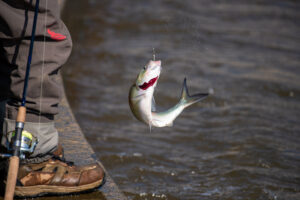NCDHHS recommends limited consumption of certain fish from parts of the Cape Fear River based on concerns about exposure to PFOS

RALEIGH — The North Carolina Department of Health and Human Services is recommending limits on consumption of certain freshwater fish from the middle and lower Cape Fear River based on concerns about exposure to perfluorooctane sulfonic acid (PFOS) found in fish sampled from that area. PFOS is part of a group of chemicals called per- and polyfluoroalkyl substances (PFAS), which are often called “forever chemicals” because they do not break down in the environment. The recommendations are based on newly available data and new information from the U.S. Environmental Protection Agency (USEPA). Many states provide recommendations to limit or avoid eating certain fish due to PFAS.
Fish advisories are issued to help people weigh for themselves the value of eating fish with the risks of pollutants fish absorb from their environment. Fish are an important source of nutrition for many North Carolinians and a good way to get lean, high-quality protein as well as healthy fats, vitamins and minerals. Some of those benefits include supporting brain development in children and improved heart health.
PFAS are an emerging public health concern with multiple potential sources of exposure, including contaminated drinking water and food, indoor dust, some consumer products and workplaces. Exposure to PFAS from fish may be higher among communities that catch and eat fish frequently. Studies have linked PFAS to several health effects, particularly after long-term exposure. These include negative effects on growth, learning and behavior in children; reduced chances of getting pregnant; impaired thyroid function; increased cholesterol levels; decreased immune system response; and increased risk of certain types of cancer, including testicular and kidney cancer.
“Studies have documented the many benefits of eating fish,” said Dr. Elizabeth Cuervo Tilson, State Health Director and NCDHHS Chief Medical Officer. “We want residents to have these recommendations so they can make informed decisions about fish consumption, particularly if they regularly catch and eat fish from this part of the Cape Fear River.”
Advisories for specific species and groups of people are listed in the table below. Advisory limits are lower for women of childbearing age, pregnant women, nursing mothers and children since these groups may be more sensitive to health effects from PFAS exposure.
| Freshwater Fish Species | Advisory for Women of Childbearing Age (15 to 44 years), Pregnant Women, Nursing Mothers and Children |
| American Shad, Blue Catfish, Channel Catfish | No more than 1 meal per year, combined across all species. |
| Bluegill, Flathead Catfish, Largemouth Bass, Striped Bass, Redear | Do Not Eat |
| Freshwater Fish Species | Advisory for All Other Individuals |
| American Shad, Blue Catfish, Channel Catfish | No more than 7 meals per year, combined across all species. |
| Bluegill, Flathead Catfish, Largemouth Bass, Striped Bass, Redear | No more than 1 meal per year, combined across all species. |
To better understand the levels of PFAS in fish in the middle and lower Cape Fear River, the NC Department of Environmental Quality and NC Wildlife Resources Commission collected and tested fish from the species that are most frequently caught and consumed in North Carolina based on surveys by the NCWRC.
PFAS were found in all species tested. Levels of PFOS were higher in Bluegill, Flathead Catfish, Largemouth Bass, Striped Bass and Redear. Levels were lower in American Shad, Blue Catfish and Channel Catfish. The PFOS concentrations were similar to those measured in fish from other states, based on recent data from the USEPA.
Other states, like Michigan, Wisconsin and Pennsylvania, also have site-specific PFAS fish advisories. These advisories range from “do not eat” to one meal per week. The new North Carolina advisories are lower than many other states because they use a new lower reference dose for PFOS released by USEPA in March 2023. North Carolina also has existing fish advisories related to mercury and other contaminants.
“Communities in the middle and lower Cape Fear Region have been requesting information about PFAS in fish since GenX was found in the river,” said Dr. Zack Moore, NCDHHS State Epidemiologist. “There are no easy answers, but we hope this information will help residents make the best decisions for themselves and their families.”
People with concerns about possible health effects of PFAS exposures can use the NCDHHS Clinician Memo to discuss these concerns with their health care provider. Since PFAS are present at low levels in many food products and in the environment, you probably cannot prevent PFAS exposure altogether. However, you can take steps to reduce your risk of exposure See more information here: https://www.atsdr.cdc.gov/pfas/resources/pfas-faqs.html.
NCDHHS is working with local health departments and community-based organizations to help share information about PFAS in fish. This information is posted on the NCDHHS fish consumption advisories webpage, along with information about the sampling plan and the levels of PFAS that were found. This information will be updated as additional data becomes available.
Across the country, scientists are working to learn more about PFAS and their impact on health. NCDHHS will continue working with NCDEQ, local health departments, academic researchers, community partners and others to respond to community concerns about PFAS. For more information regarding state efforts to address PFAS, please visit the NCDHHS PFAS webpage and the NCDEQ PFAS webpage.
FAQs about these recommendations can be found here: English, Spanish.

Figure 1:
A map of the middle and lower regions of the Cape Fear River, N.C., annotated to highlight the region covered by the PFOS fish consumption advisory, which is bounded by the Fayetteville Boat Ramp and the Bluffs on the Cape Fear. The map was created by Jared Wilson (NCDEQ) using ArcPro (ESRI).
